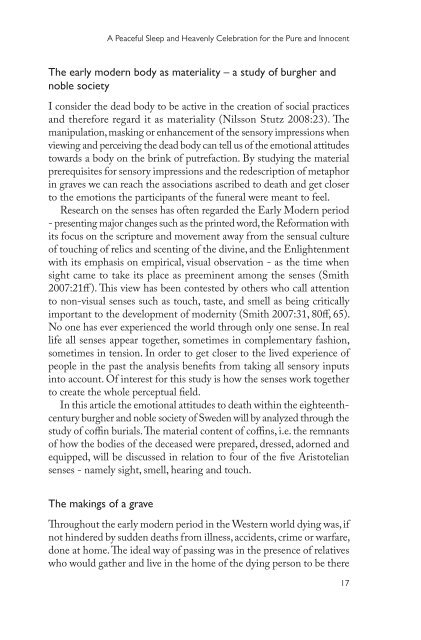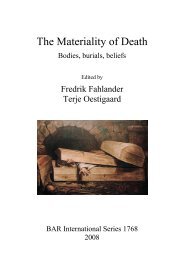Making Sense of Things
Making Sense of Things
Making Sense of Things
Create successful ePaper yourself
Turn your PDF publications into a flip-book with our unique Google optimized e-Paper software.
A Peaceful Sleep and Heavenly Celebration for the Pure and Innocent<br />
The early modern body as materiality – a study <strong>of</strong> burgher and<br />
noble society<br />
I consider the dead body to be active in the creation <strong>of</strong> social practices<br />
and therefore regard it as materiality (Nilsson Stutz 2008:23). The<br />
manipulation, masking or enhancement <strong>of</strong> the sensory impressions when<br />
viewing and perceiving the dead body can tell us <strong>of</strong> the emotional attitudes<br />
towards a body on the brink <strong>of</strong> putrefaction. By studying the material<br />
prerequisites for sensory impressions and the redescription <strong>of</strong> metaphor<br />
in graves we can reach the associations ascribed to death and get closer<br />
to the emotions the participants <strong>of</strong> the funeral were meant to feel.<br />
Research on the senses has <strong>of</strong>ten regarded the Early Modern period<br />
- presenting major changes such as the printed word, the Reformation with<br />
its focus on the scripture and movement away from the sensual culture<br />
<strong>of</strong> touching <strong>of</strong> relics and scenting <strong>of</strong> the divine, and the Enlightenment<br />
with its emphasis on empirical, visual observation - as the time when<br />
sight came to take its place as preeminent among the senses (Smith<br />
2007:21ff). This view has been contested by others who call attention<br />
to non-visual senses such as touch, taste, and smell as being critically<br />
important to the development <strong>of</strong> modernity (Smith 2007:31, 80ff, 65).<br />
No one has ever experienced the world through only one sense. In real<br />
life all senses appear together, sometimes in complementary fashion,<br />
sometimes in tension. In order to get closer to the lived experience <strong>of</strong><br />
people in the past the analysis benefits from taking all sensory inputs<br />
into account. Of interest for this study is how the senses work together<br />
to create the whole perceptual field.<br />
In this article the emotional attitudes to death within the eighteenthcentury<br />
burgher and noble society <strong>of</strong> Sweden will by analyzed through the<br />
study <strong>of</strong> c<strong>of</strong>fin burials. The material content <strong>of</strong> c<strong>of</strong>fins, i.e. the remnants<br />
<strong>of</strong> how the bodies <strong>of</strong> the deceased were prepared, dressed, adorned and<br />
equipped, will be discussed in relation to four <strong>of</strong> the five Aristotelian<br />
senses - namely sight, smell, hearing and touch.<br />
The makings <strong>of</strong> a grave<br />
Throughout the early modern period in the Western world dying was, if<br />
not hindered by sudden deaths from illness, accidents, crime or warfare,<br />
done at home. The ideal way <strong>of</strong> passing was in the presence <strong>of</strong> relatives<br />
who would gather and live in the home <strong>of</strong> the dying person to be there<br />
17

















